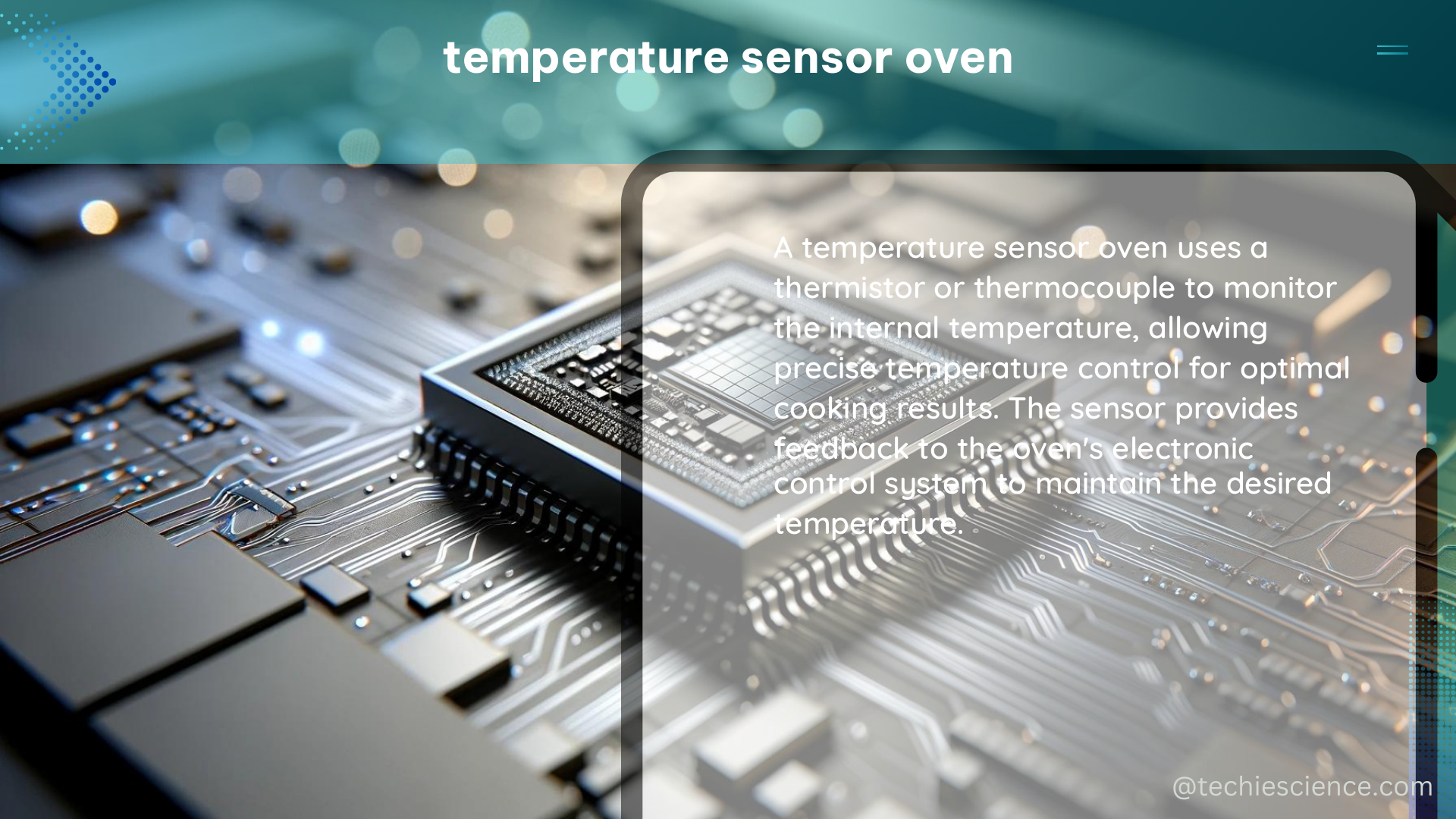The temperature sensor in an oven is a critical component that helps maintain the desired temperature inside the cooking chamber. When this sensor fails, it can cause the oven to not heat to the set temperature or display an error code related to the temperature sensor. Accurately measuring and monitoring oven temperatures is essential for ensuring the quality of the products produced and reducing energy consumption and costs.
Understanding Oven Temperature Sensors
Oven temperature sensors are typically made of thermistors or resistance temperature detectors (RTDs) that change their electrical resistance in response to changes in temperature. These sensors are strategically placed within the oven cavity to provide accurate temperature readings to the oven’s control system.
Thermistor Oven Temperature Sensors
Thermistors are the most common type of temperature sensor used in ovens. They are inexpensive, compact, and have a high sensitivity to temperature changes. Thermistors used in ovens typically have a negative temperature coefficient (NTC), meaning their resistance decreases as the temperature increases.
- Typical resistance range for oven thermistors: 10 kΩ to 100 kΩ at room temperature
- Resistance change: Approximately 4% per °C temperature change
- Accuracy: ±1°C to ±3°C
RTD Oven Temperature Sensors
Resistance temperature detectors (RTDs) are less common in household ovens but are often used in commercial and industrial ovens due to their higher accuracy and stability. RTDs are made of metals, such as platinum, and their resistance increases linearly with temperature.
- Typical resistance range for oven RTDs: 100 Ω to 1000 Ω at 0°C
- Resistance change: Approximately 0.4% per °C temperature change
- Accuracy: ±0.1°C to ±0.5°C
Oven Temperature Sensor Placement and Calibration

The placement of the temperature sensor within the oven cavity is crucial for accurate temperature measurement. Factors such as air circulation, proximity to heating elements, and the position relative to the food being cooked can all affect the sensor’s readings.
Sensor Placement Considerations
- Avoid direct exposure to heating elements or radiant heat sources
- Position the sensor away from the oven door to minimize the impact of opening and closing
- Ensure the sensor is not obstructed by racks, bakeware, or food items
- Consider the airflow patterns within the oven to optimize sensor placement
Sensor Calibration
Oven temperature sensors may require periodic calibration to ensure accurate readings. This can be done by comparing the sensor’s readings to a known reference, such as a calibrated thermometer or a temperature-controlled environment.
- Typical oven temperature sensor calibration range: ±10°C to ±25°C
- Calibration frequency: Annually or as recommended by the manufacturer
Advanced Temperature Measurement Techniques
For more precise temperature monitoring in ovens, particularly in industrial or research settings, specialized techniques and equipment may be employed.
Heat Flux and Temperature Measurement
Researchers have developed sensors that can simultaneously measure heat flux and temperature within an oven. These sensors are strategically placed at multiple locations to collect comprehensive data on the oven’s thermal performance.
- Sensor placement: Shuffled between different test runs to ensure accurate data collection
- Measurement parameters: Heat flux, oven temperature, and temperature gradients
- Applications: Oven design optimization, energy efficiency studies, and product quality control
Temperature Profiling
Mapping the temperature distribution within an oven can provide valuable insights into its performance and the factors that influence it. This is often done by using multiple thermocouples or other temperature sensors placed at various locations inside the oven.
- Sensor arrangement: Thermocouples soldered onto a printed circuit board
- Measurement locations: Top, middle, and bottom of the oven cavity
- Findings: Temperature profiles can vary significantly based on oven make, model, and condition
Thermal Protection for Sensor Monitoring
In high-temperature environments, such as industrial or food ovens, special arrangements may be necessary to protect the temperature monitoring equipment from the extreme conditions.
- Data logger enclosure: Placed inside a thermal case to shield it from high temperatures
- Sensor placement: Kept in contact with the oven’s ambient temperature to transmit data
- Applications: Continuous temperature monitoring in challenging oven environments
Conclusion
The temperature sensor is a crucial component in an oven, responsible for maintaining the desired cooking temperature and ensuring the quality of the final product. Understanding the principles of oven temperature sensors, their placement, calibration, and advanced measurement techniques can help ensure accurate temperature monitoring and control in a wide range of oven applications.
References
- Development and applications of a sensor for heat flux and temperature measurement in an oven. ThinkIR. Retrieved from https://ir.library.louisville.edu/cgi/viewcontent.cgi?article=5243&context=etd
- Temperature Profiles in Home Ovens and Refrigerators. PHYS 398 DLP Spring 2020. Retrieved from https://courses.physics.illinois.edu/phys398dlp/fa2020/documents/8_report.pdf
- Temperature measurement in ovens. Tecnosoft srl. Retrieved from https://www.tecnosoft.eu/en/news/temperature-measurement-ovens/

The lambdageeks.com Core SME Team is a group of experienced subject matter experts from diverse scientific and technical fields including Physics, Chemistry, Technology,Electronics & Electrical Engineering, Automotive, Mechanical Engineering. Our team collaborates to create high-quality, well-researched articles on a wide range of science and technology topics for the lambdageeks.com website.
All Our Senior SME are having more than 7 Years of experience in the respective fields . They are either Working Industry Professionals or assocaited With different Universities. Refer Our Authors Page to get to know About our Core SMEs.